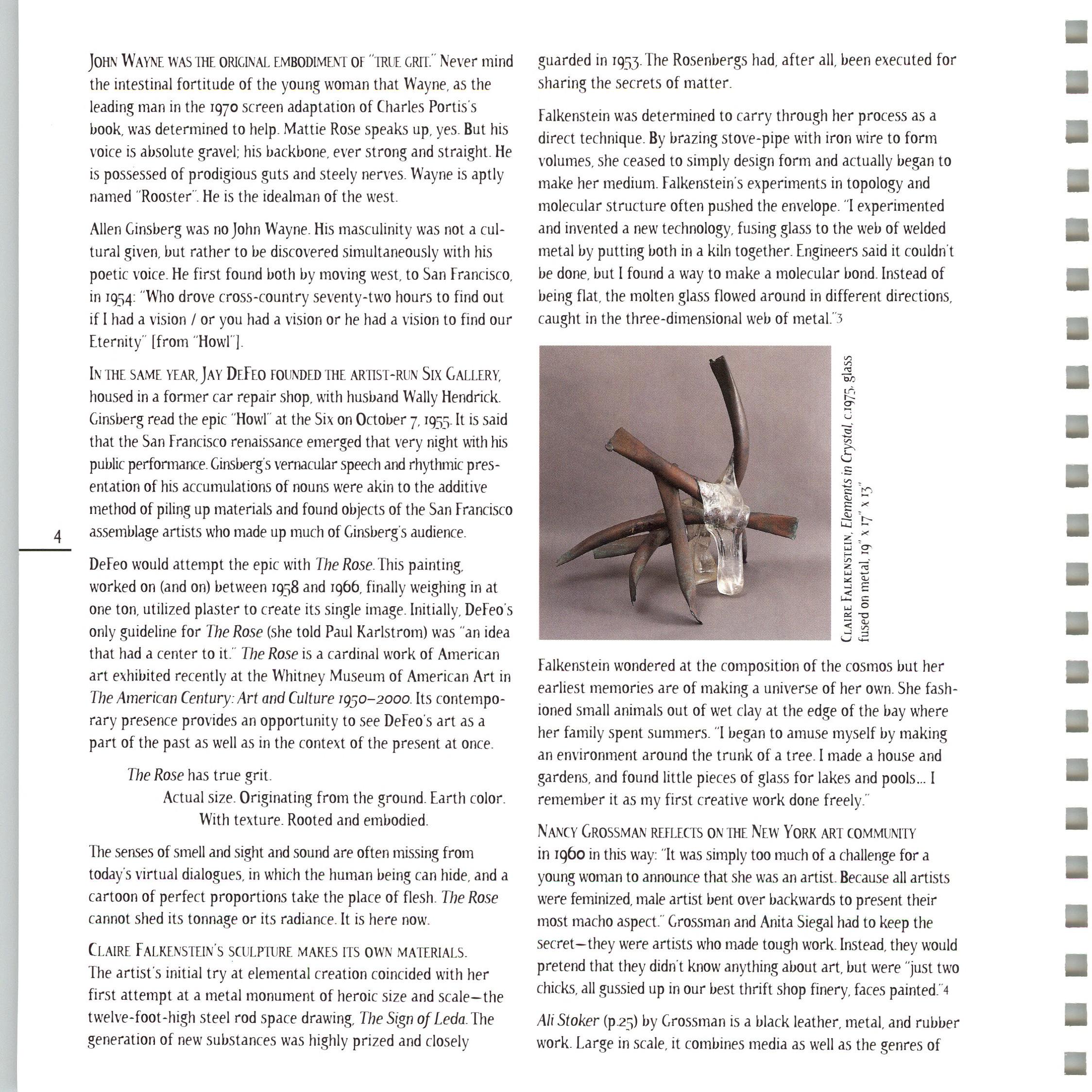
4 minute read
Nevelson quoted in Nevelson and Diana Mackown. Dawns and Dusks. (New York: Charles
painting, sculpture, and collage in a fierce and spirited turnout of the machine-animal figure that had appeared in her work during the earlier years o f the decade. It was 1967, when 50,000 protesters had demonstrated against the Vietnam W ar at the Lincoln M emorial in Washington, D.C. For me. Ah S toker reveals the innards of the war machine and, at the same time, the flayed intestines of its many victims.
Walrus (1966) (p.2) is a tondo o f leather elements m asterfully locked together. M asters and Johnson's surprising report on human sexual response had just been published. 1 cannot but think that the two events share a synergy. An emblem of the female, Walrus is composed as well, of the tough hide that protected the femininity o f women artists before the second wave recontextualized their complicated musings on gender and sexuality.
Lee B o n teco u 's i960 U n m w (p.9), a wall assemblage o f welded steel and canvas, employs worn cloth from a laundry conveyer belt. Bontecou combined leather and metal when she sewed this canvas onto its frame with wire. But what one sees p rim arily is the gaping hole. Steel choppers inside o f a wire lip. The ferocious mouth that bites and doesn't need lipstick. The artist describes this body of assemblages as angry "like war equipment,' and "with teeth.' A number of her pieces ended up in Germany and Israel. "Just where they belonged, without my saying a thing.” As embodiments of past, present and future, Bontecou's efforts speak, as well, to Saigon, Kosovo, Grenada, and Oklahoma.
L ouise Nevelson' s untitled painted construction o f c.1955 (p. 28) is made o f wood 1 have seen on New York City streets many times The knots and rings, clefs and splits of the timber come through the sheer gray/black color that seeps in and stains. The upright post looks as if it has been forcefully stru ck into the horizontal piece below. Yet, it is also slightly curved at the bottom, rendering the balance tender and precarious. Three pieces o f scored wood on the lower portion used as slightly skewed lines in a written communique. Screws in the two sm aller members stick out straight through the wooden "body. The d iary o f Anne Frank had been published that same year, bringing up and underlining the intolerable sacrifice of the innocent. Nevelon s somber p illar might be a grave m arker. Four bolts pierce the front. The horizontal arm s have been broken, yet the nails remain.
Nevelson did not begin with the beautiful, but with what is. Out of the cast-offs o f her urban community, she made a monument of quite dignity. Wretched refuse, she perceived, contains a truth that describes itself through the circle drawn to exclude it— and one that must be told from the outside to all who dwell within. "1 never doubted that my life would fulfill itself ...or I wouldn't have had the courage. You see, I hate the world com prom ise...l knew that I needed to claim m y total l i f e '5
Dream House (1972) (p-29) is a cabinet that opens to uncover a single column placed on a pedestal. A p illa r within a pier, this home and the figure inside are both singular and idiosyncratic. Self-made self and articulated environment are protected and transparent, ideal and entirely actual.
T r u e G r it a ss u m e s n o t h in g a b o u t th e s e a r t i s t s a c c o r d in g to their gender. Their individualistic eccentricities make any classification o f the seven artists so named difficult and imperfect. Indeed it is their very ungroupability that creates the character o f the ensemble. What can be said with assurance is that they are among the best of their generation and have made bodies o f w ork that are tough, deep and absorbing.
With the hope that true grit will earn its redress in the end, Peggy Guggenheim envisioned the moment o f satisfaction for Claire Falkenstein:
Claire entered the gates of paradise. She was met by Saint Peter who said "What are you doing here uninvited? No one can pass these gates without my permission.” But,” replies Claire, "1 made these gates m yself with my own hands. "In that case,” replied St. Peter, "you are welcome. M y child.' 6
But Abby Hoffman can tell you that resistance does not as a rule beget reward. In an interview with A rbus in 1969, he reflected that "Death or the fact that you might die at what you're doing is something that...that I can face in my mind and deal with and...overcome. I've overcome my fear o f death. I've not overcome my fear of jail.”7
Arlene Raven, PhD
1. Bourgeois, interview with Donald Kuspit. Elizabeth Avedon Editions, Vintage Books, p.jj. 2. Spero quoted in Jon Bird, "Nancy Spero Inscribing Woman—Between the Lines," in Nancy
Spero (London: ICA/Fruitmarket Gallery/Orchard Gallery/Foyle Arts Project. 1987, pp.24-25. 3. Falkenstein. interview with Charlotte Streifer Rubinstein. 1980. 4. Raven, p.985. Nevelson quoted in Nevelson and Diana Mackown. Dawns and Dusks. (New York: Charles
Scribner's Sons, 1976), p.42. 6. Peggy Guggenheim, "The New Gates of Paradise, 1961. Archives of Claire Falkenstein. 7. Avedon. p.4.




